
Too-high home prices cause demand destruction on an epic scale. Buyers’ strike continues in November and December.
By Wolf Richter for WOLF STREET.
Demand for existing homes has wilted in an amazing manner and is wobbling along rock-bottom. Sales of existing single-family houses, condos, and co-ops that closed in October came in at a seasonally adjusted annual rate of 3.96 million, according to the National Association of Realtors (NAR) today. This was a slight uptick from downwardly revised September.
These below-4-million sales rates, which started in September 2023, are the lowest since the worst months of the Housing Bust. Compared to the collapsed sales rate in October 2023, sales rose by 2.9%. Compared to October 2022, sales were down 36%. Compared to October 2019, sales were down 26.8% (historic data via YCharts):
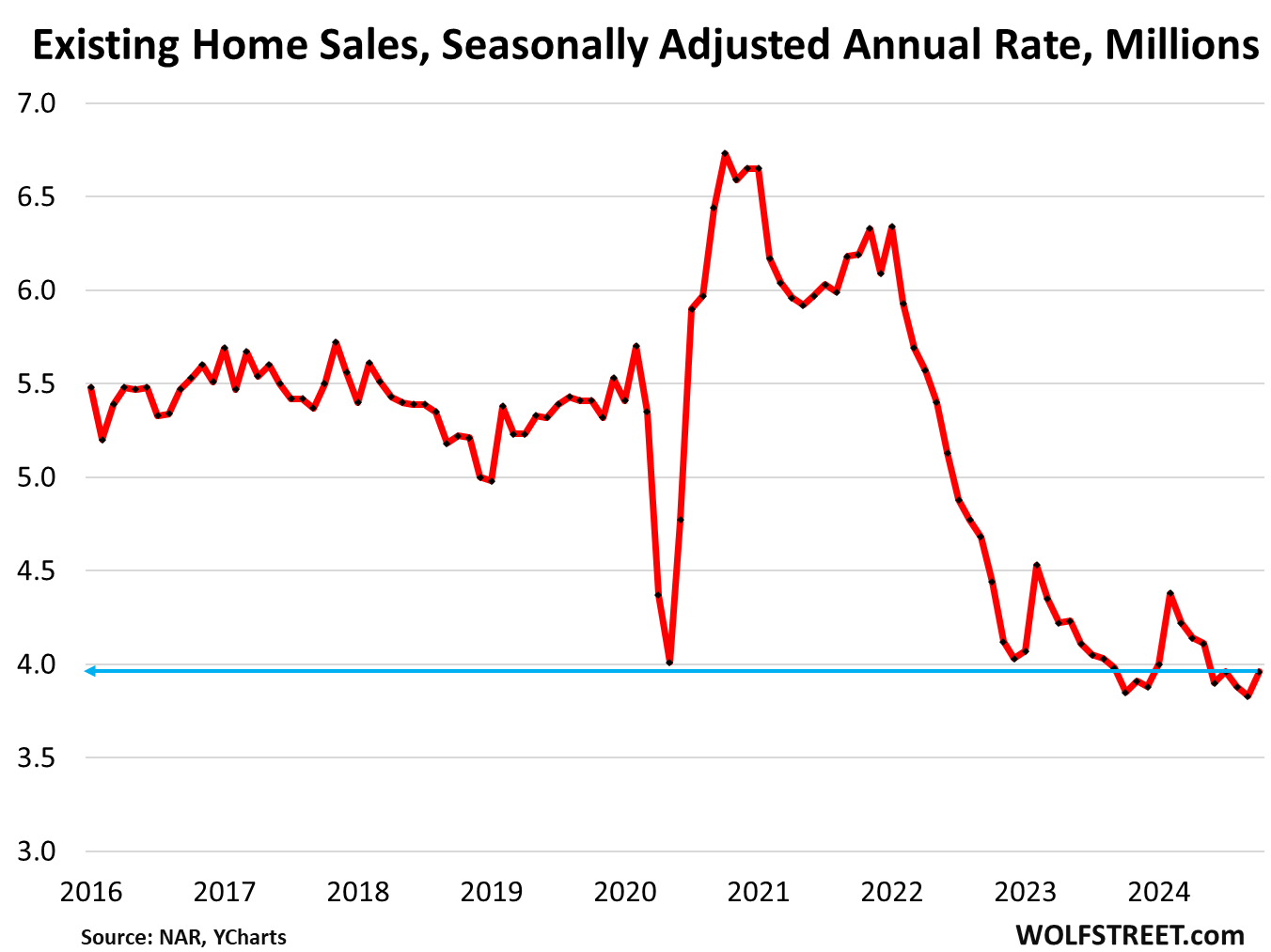
Too-high prices cause demand destruction on an epic scale.
Actual home sales in October (not seasonally adjusted, not annual rate) ticked up to 348,000 homes. For the 10 months of 2024 so far, actual sales at 3.42 million were down by 2.1% from the crushed levels of the same period last year.
With today’s sales figures, the WOLF STREET estimate for whole-year sales in 2024 comes in at 4.02 million sales, the lowest since 1995, below the worst year of the Housing Bust, 2008, with 4.11 million sales.
This demand destruction is even larger than during the Housing Bust. But during the Housing Bust, demand destruction was caused by an economic and financial meltdown, as the unemployment rate shot to 10% and millions of people lost their jobs and couldn’t make their mortgage payments, and as reckless mortgage lending in prior years bore fruit.
This time around, demand destruction is caused by the gigantic spike in prices – they’re now way too high (historical data from YCharts).
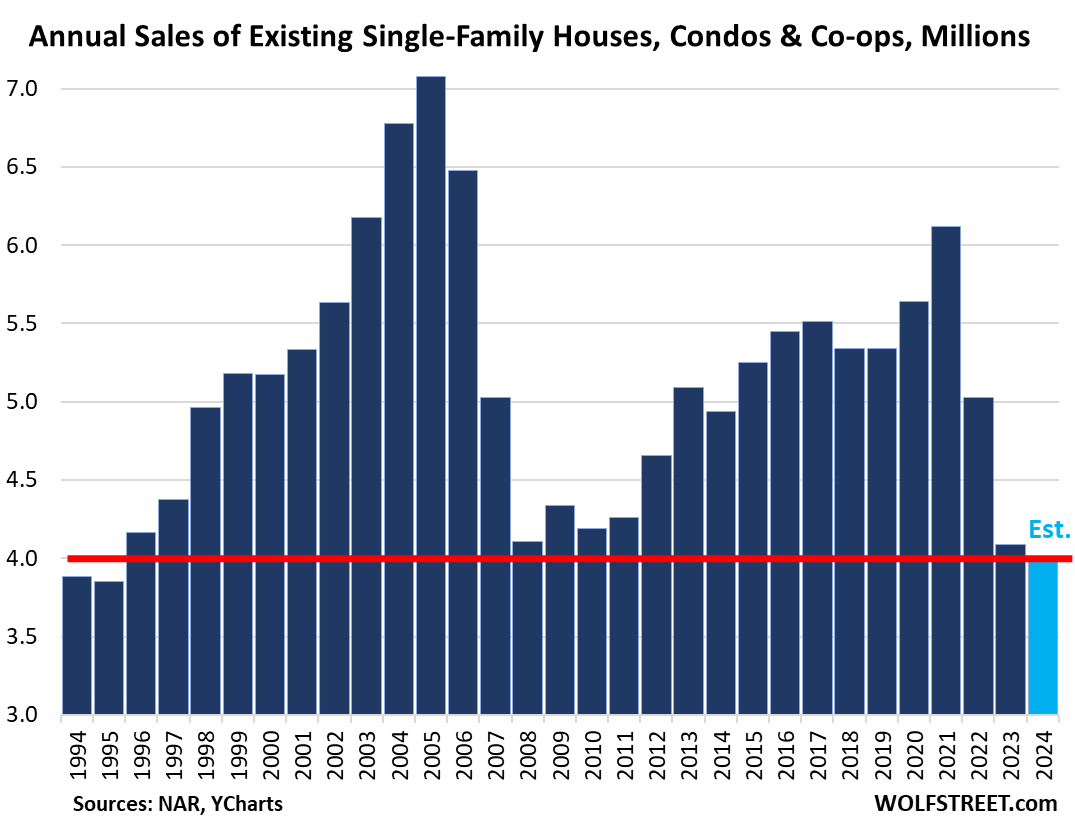
Buyers’ strike continues in November and December.
The weekly measure of mortgage applications to purchase a home has been near the historic lows over the past six weeks, including in the latest reporting week, down by 50% from the same period in 2019, according to data from the Mortgage Bankers Association yesterday.
This is an indication that buyers who would need a mortgage to purchase a home will still be on buyers’ strike in November and December, in terms of the closed sales reported by the NAR.
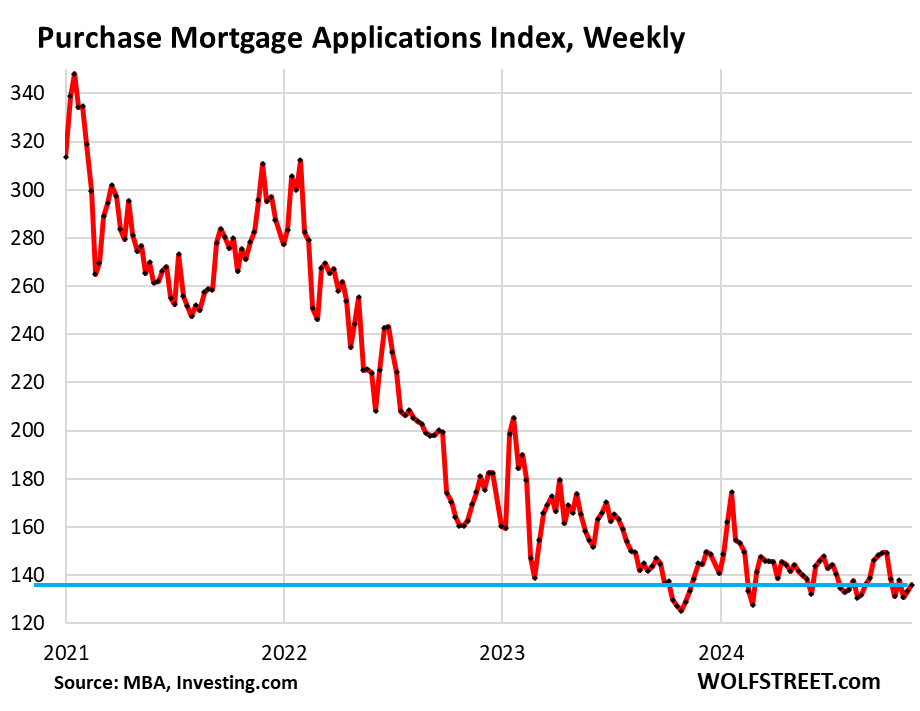
Supply second highest for any October in 7 years, behind only 2018.
Unsold inventory dipped to 1.37 million homes in October, from 1.39 million in September, which had been the highest in four years, and up by 19% from a year ago, according to NAR data.
Inventory of single-family houses was unchanged at 1.19 million, or 4.0 months’ supply (up from 3.5 months a year ago).
Inventory of condos and co-ops rose to 175,000, or 5.5 months’ supply (up from 4.0 months a year ago).
As demand has wilted this year and inventory has risen, supply in October at 4.2 months (red in the chart below) was the second highest for any October in the past 7 years, behind only October 2018 with 4.3 months (yellow):
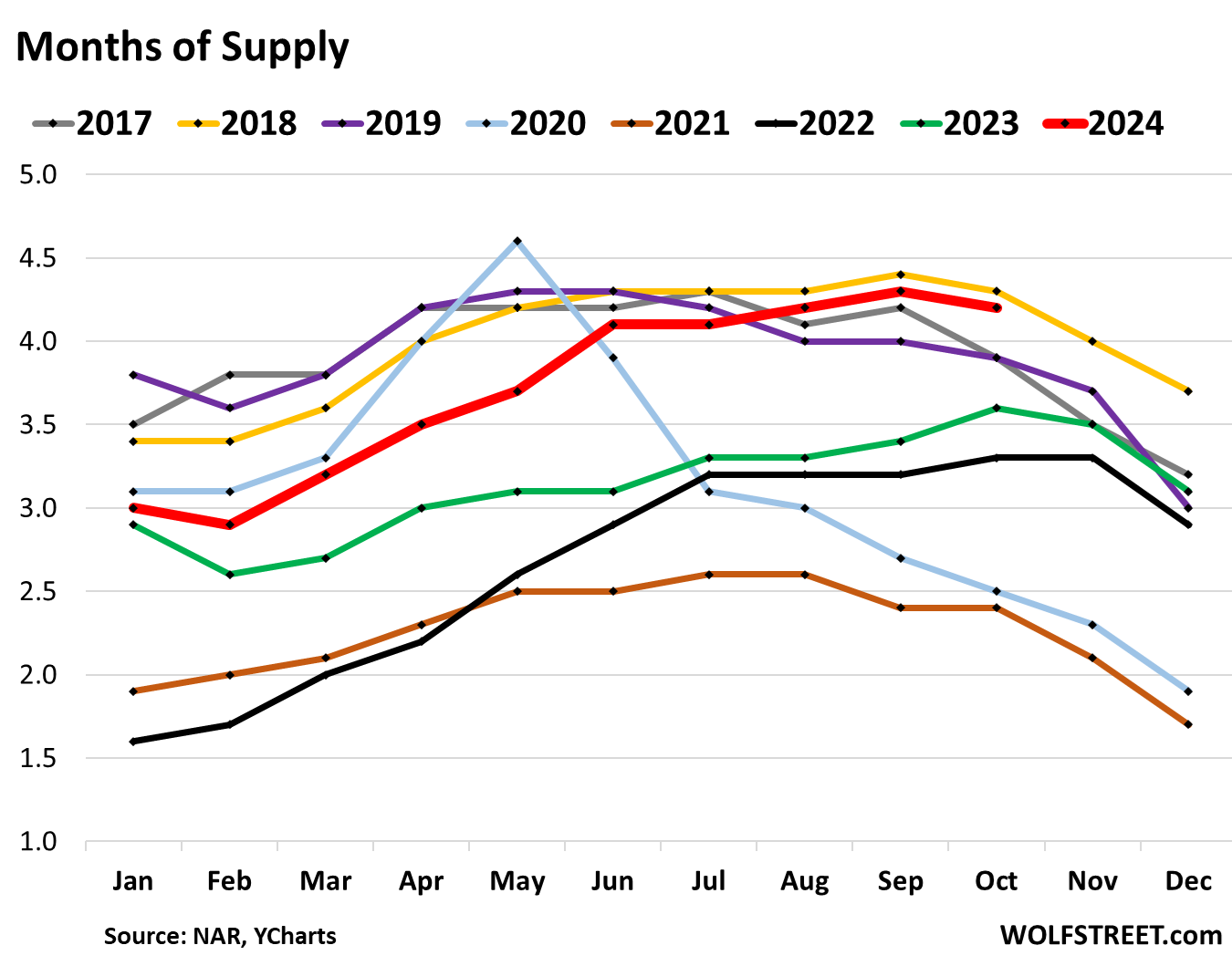
Days on the market rise.
The median number of days before the home is either sold or pulled off the market because it failed to sell rose to 58 days in October, the most for any October since 2019, and up from 50 days a year ago, according to data from Realtor.com. This is in part a measure of how motivated or unmotivated sellers are.
When sellers are motivated and getting impatient or desperate, they will leave their unsold home on the market and cut prices until it sells, and the median number of days homes spent on the market rises.
When sellers are unmotivated, they pull unsold homes off the market quickly if there is no action, and the median number of days on the market falls. Sellers are still not very motivated, but are getting more so:
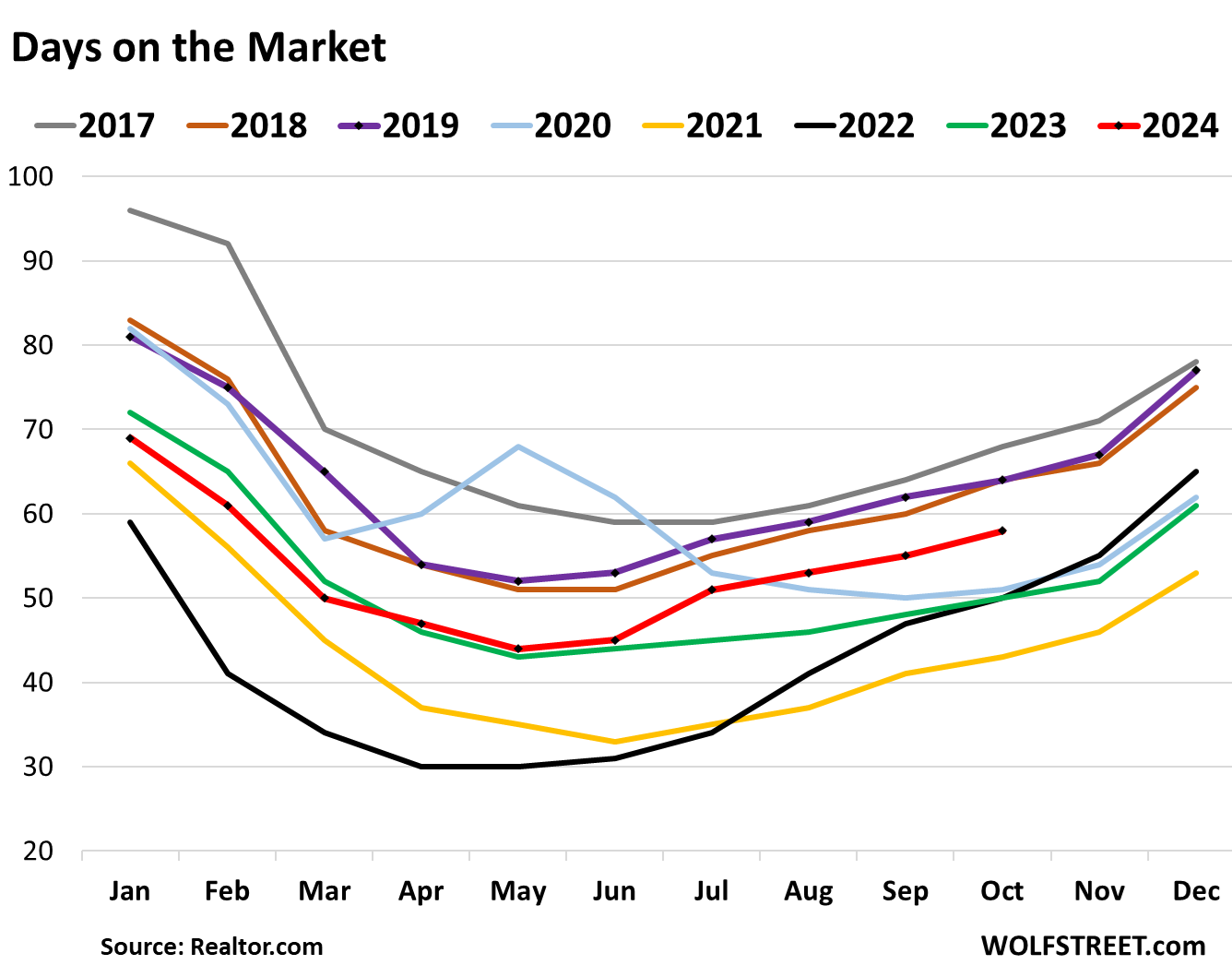
The 7% mortgages are back.
The average 30-year fixed mortgage rate rose to 6.84%, according to Freddie Mac’s weekly measure today.
The daily measure by Mortgage News Daily has been above 7% since October 28 with the exception of two days.
Since early October, Freddie Mac’s measure of mortgage rates has at first ticked up and then surged by 76 basis points, thereby undoing part of the rate-cut mania plunge that kicked off a year ago.
But these higher rates in October haven’t been reflected in the closed-sales figures in October, as those deals were made in prior weeks or months. But they are reflected in the mortgage applications, see above.
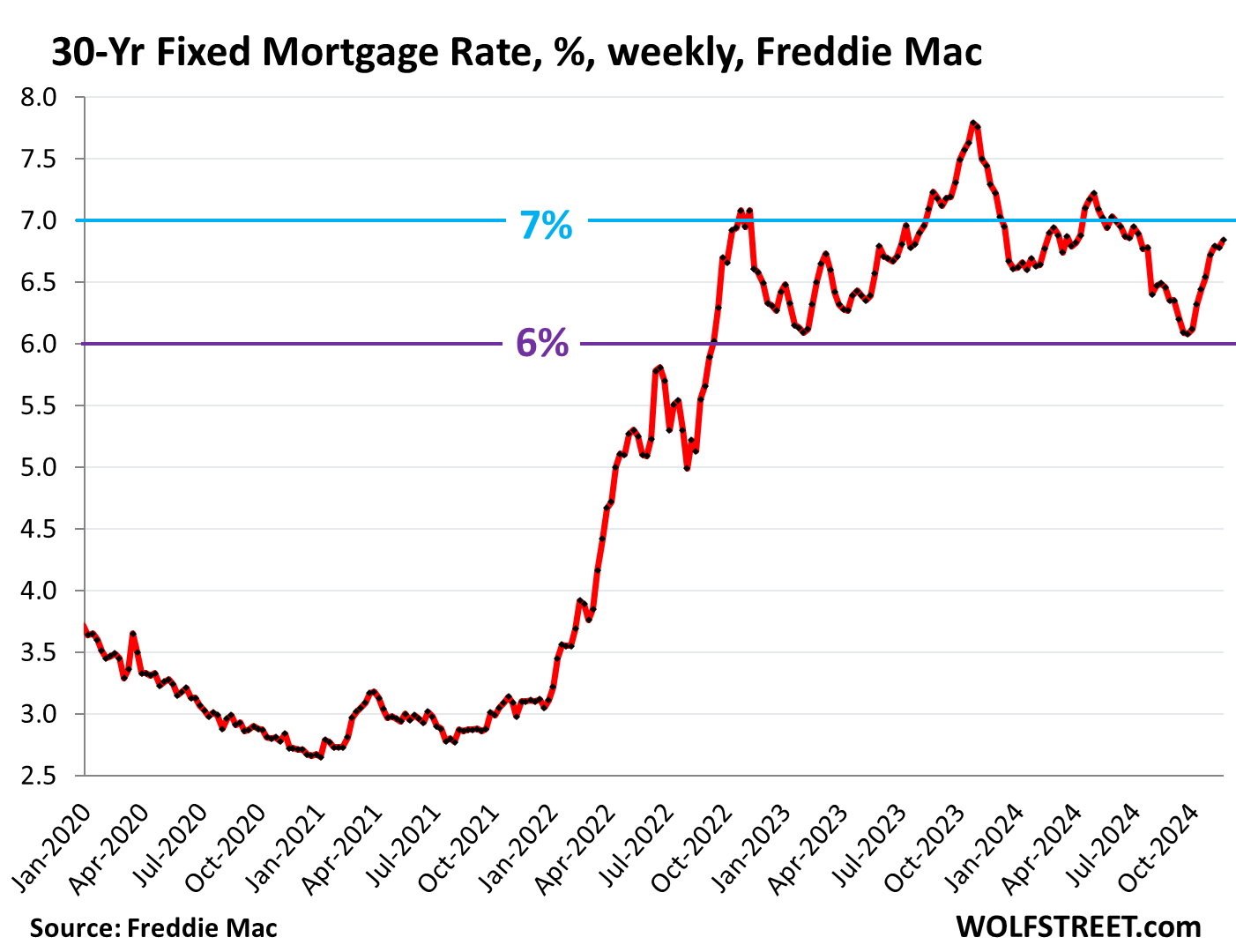
The median price of single-family houses edged up by $800 in October to $412,200, in line with seasonal upticks or flat spots in October through December (circled). Year-over-year, the price was up by 4.1%.
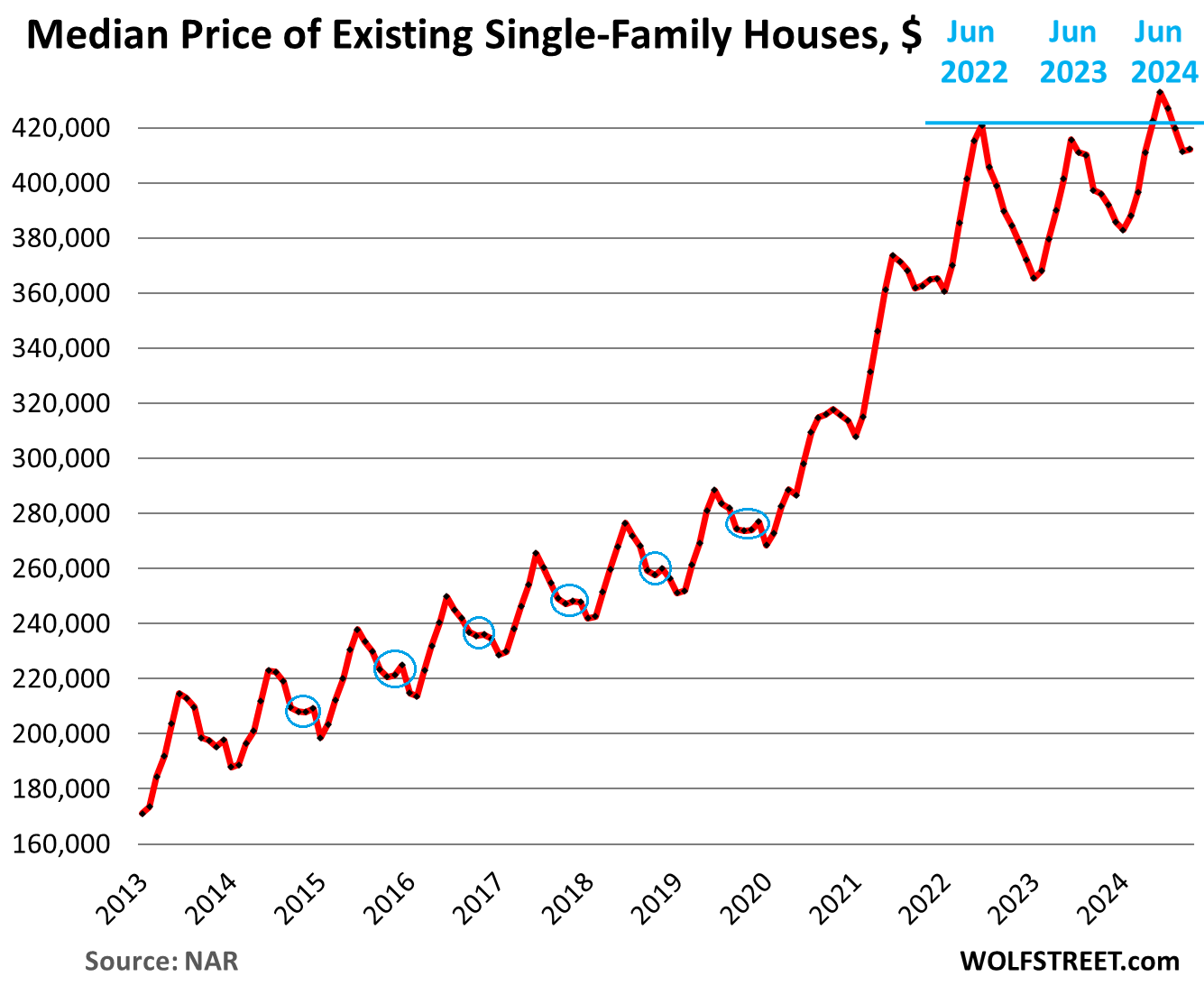
The median price of condos and co-ops dipped by $2,200 to $360,300 in October, which whittled down the year-over-year gain to 1.6%, the smallest gain since May 2023. Unlike single-family house prices, condo prices didn’t book any year-over-year declines in mid-2023, but very small rises.
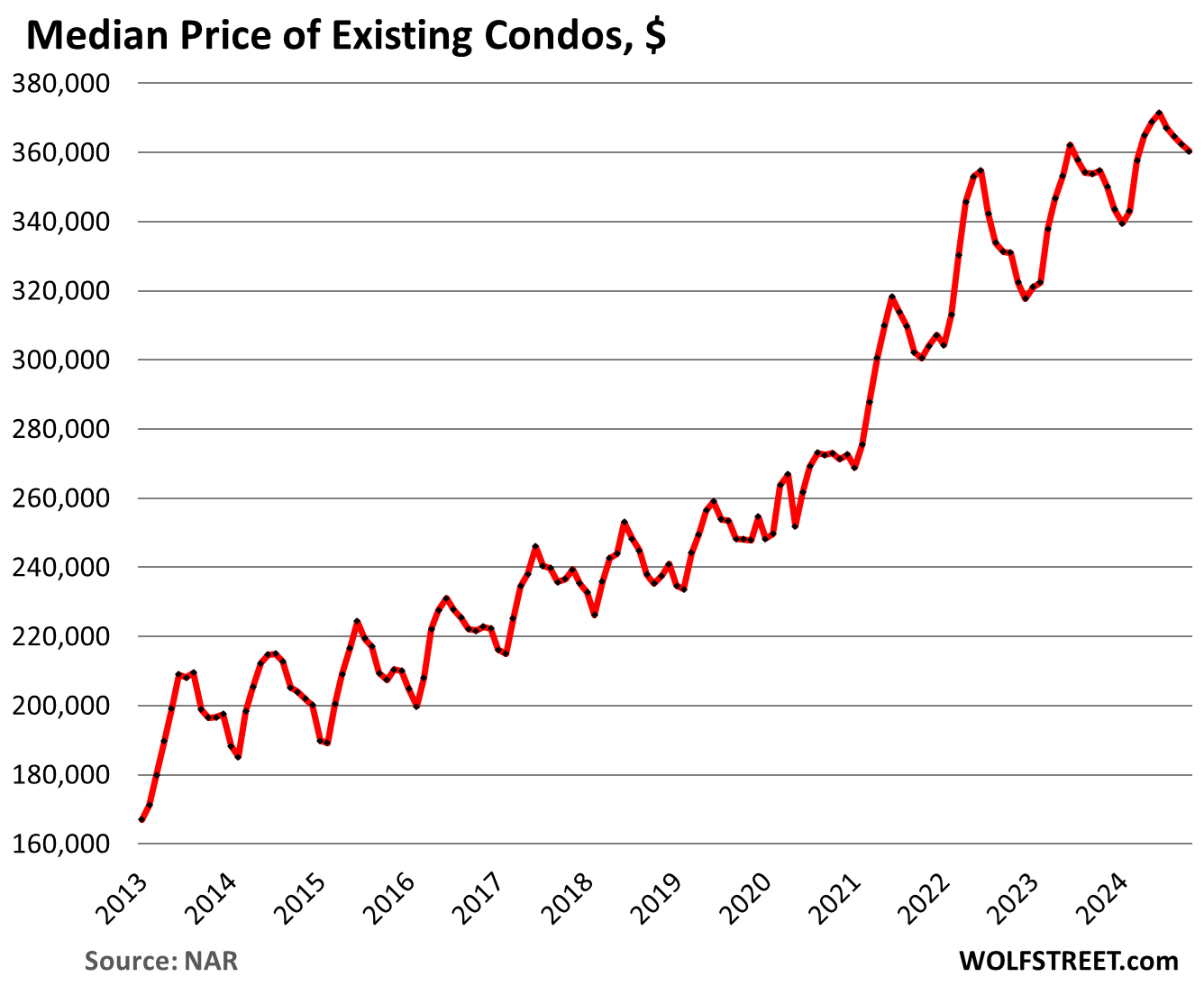
Home prices vary widely by metro.
After spiking ridiculously in the prior years, home prices have begun to drop in some metros, such as in Austin (so far -20.4% from the peak in mid-2022), while in other metros, prices have risen until more recently. Of the 30 metros in our lineup of The Most Splendid Housing Bubbles in America, only the New York City metro eked out a new high in October. And there was everything in between. These are the two bookends of the 30 Most Splendid Housing bubbles:
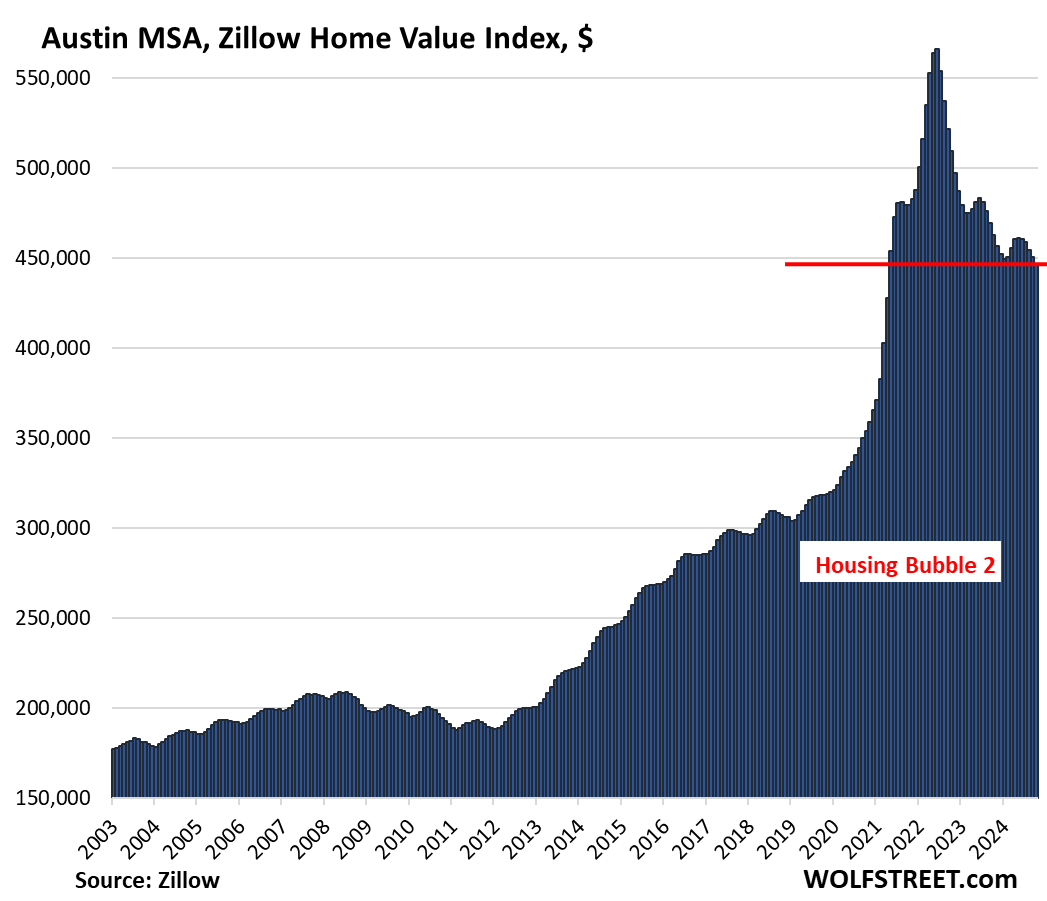
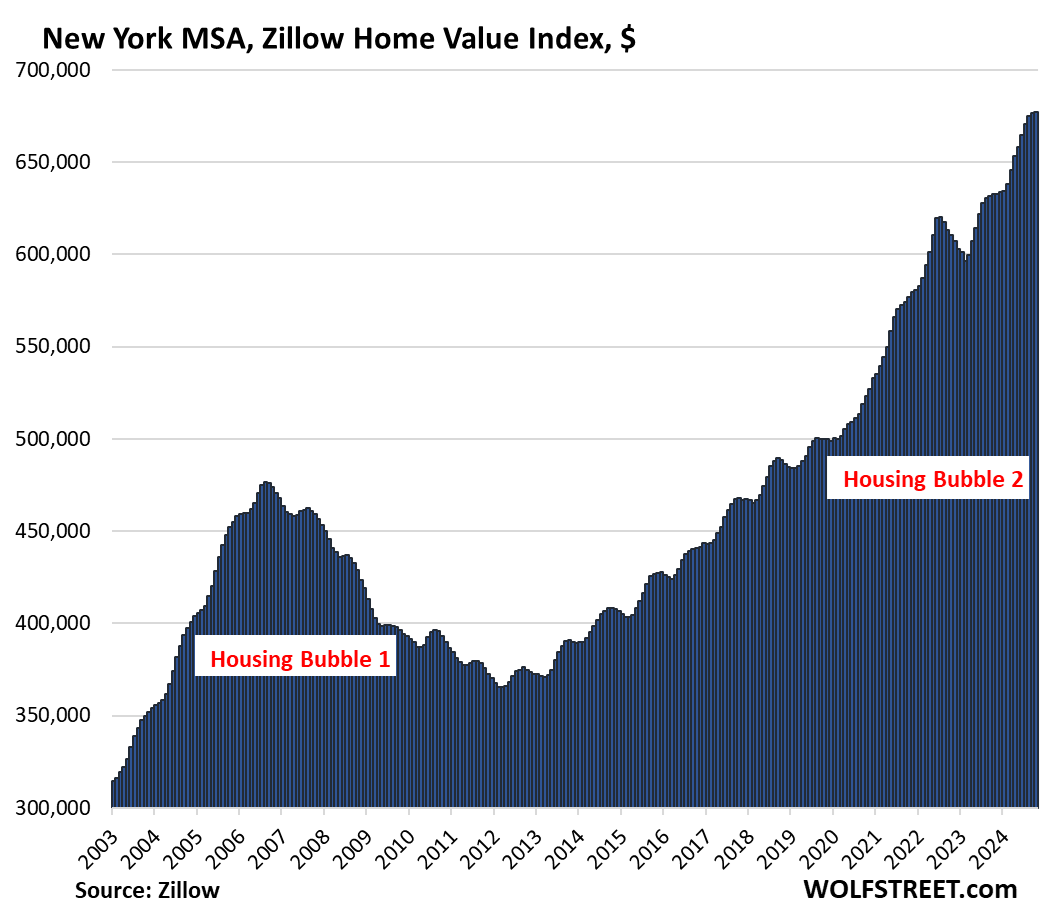
NAR blames everything except the problem: too-high prices.
The median price of existing homes reported by the National Association of Realtors exploded by nearly 50% from early 2020 through mid-2022, fueled by the Fed’s interest rate repression and many trillions of dollars of free money. It was the craziest 2.5-year frenzy ever in the US housing market, as a result of which prices are way too high, and those now way-too-high prices have destroyed demand, and buyers are on strike.
But the NAR always blames something other than the way-too-high prices for the collapse in demand: Last year, it blamed the inventory, then it blamed the surge in mortgage rates. Last month, it blamed “consumers hesitating” before the “upcoming election.” But the NAR always sees green shoots despite the too-high prices: “The worst of the downturn in home sales could be over, with increasing inventory leading to more transactions,” it said today, which are the same green shoots it has been seeing for two years. But it never sees the too-high prices as the fundamental issue now crushing the housing market and the industry that makes its living from selling homes – the industry that the NAR represents.
Meanwhile, commercial real estate spent the past two years massively repricing properties. And deals are now happening because prices have plunged to where they start making sense again. And homebuilders have figured it out too: To keep building and to keep their sales up, they’re offering homes at lower prices and with big incentives and costly mortgage-rate buydowns, and they’re eating market share from sellers of existing homes.
And potential buyers have figured it out, with an ever-larger number profiting from, or planning to profit from, the arbitrage of renting a home versus buying an equivalent home, and saving thousands of dollars a month in many high-priced markets.
Demand destruction by region.
The charts below show the seasonally adjusted annual rate of sales, released by the NAR today, in the four Census Regions of the US. A map of the four regions is in the comments below the article.
Northeastern US: The seasonally adjusted annual rate of sales rose to 470,000 homes:
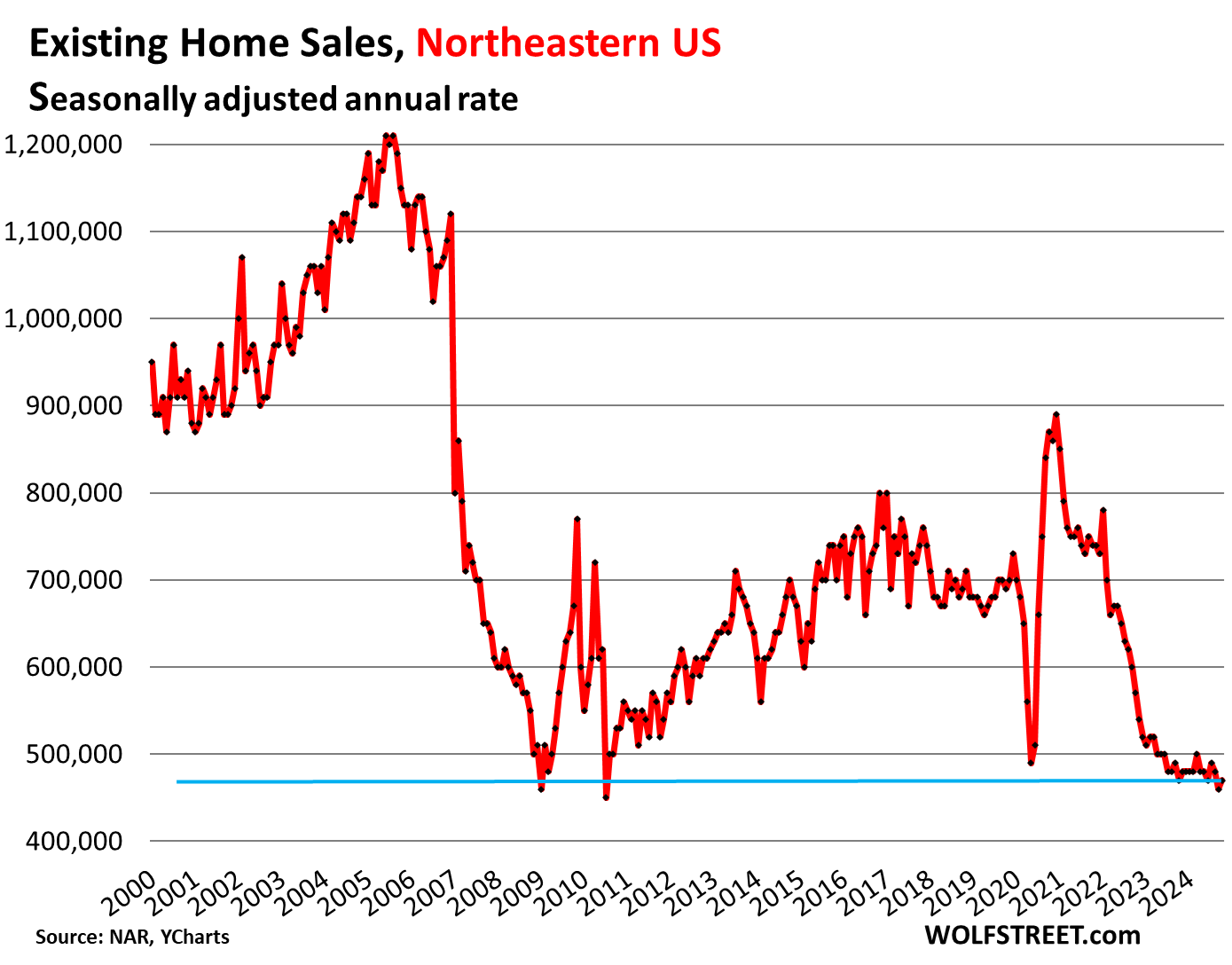
Midwestern US: The seasonally adjusted annual rate of sales rose to 950,000 homes.
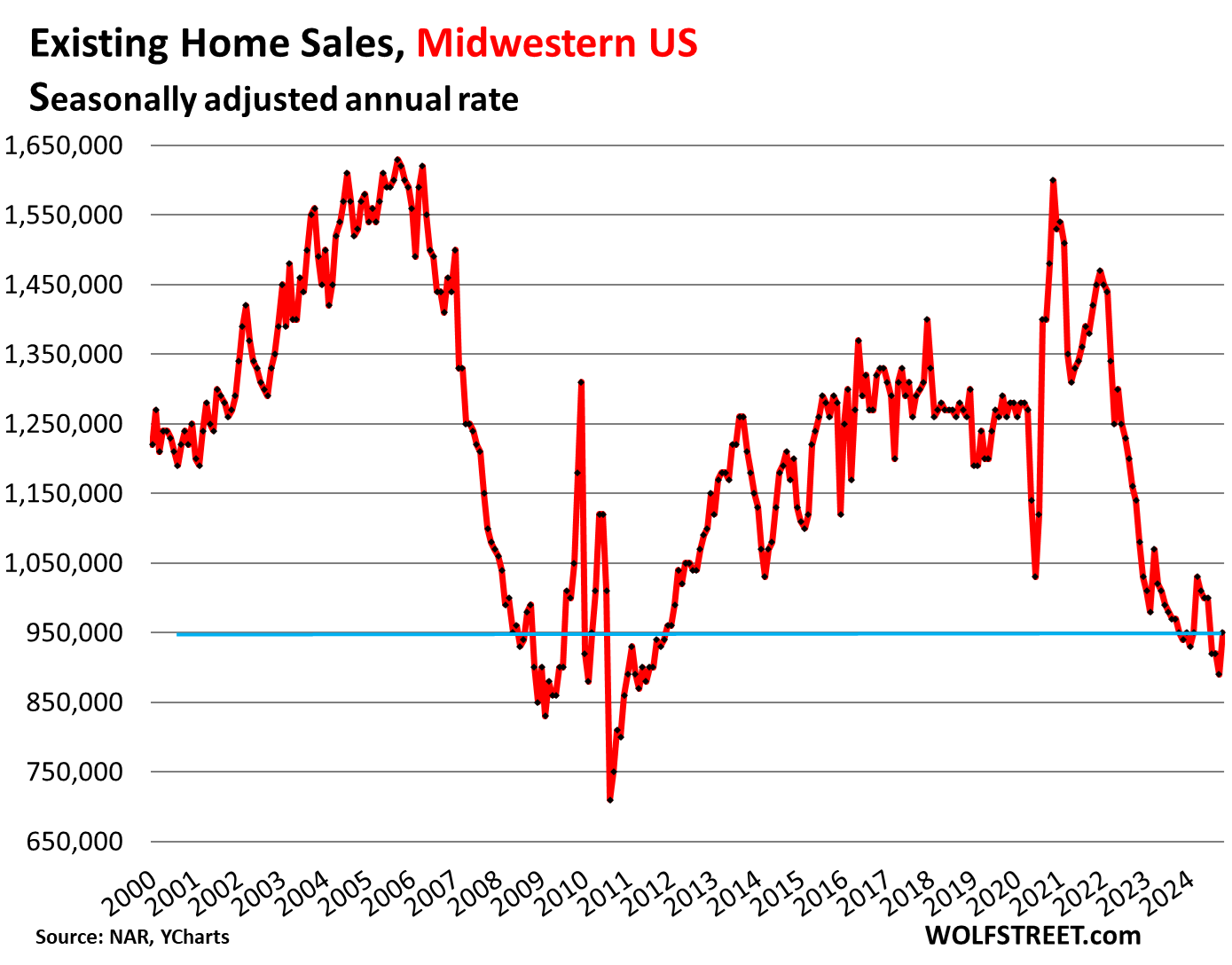
Southern US: The seasonally adjusted annual rate of sales rose to 1,770,000 homes.
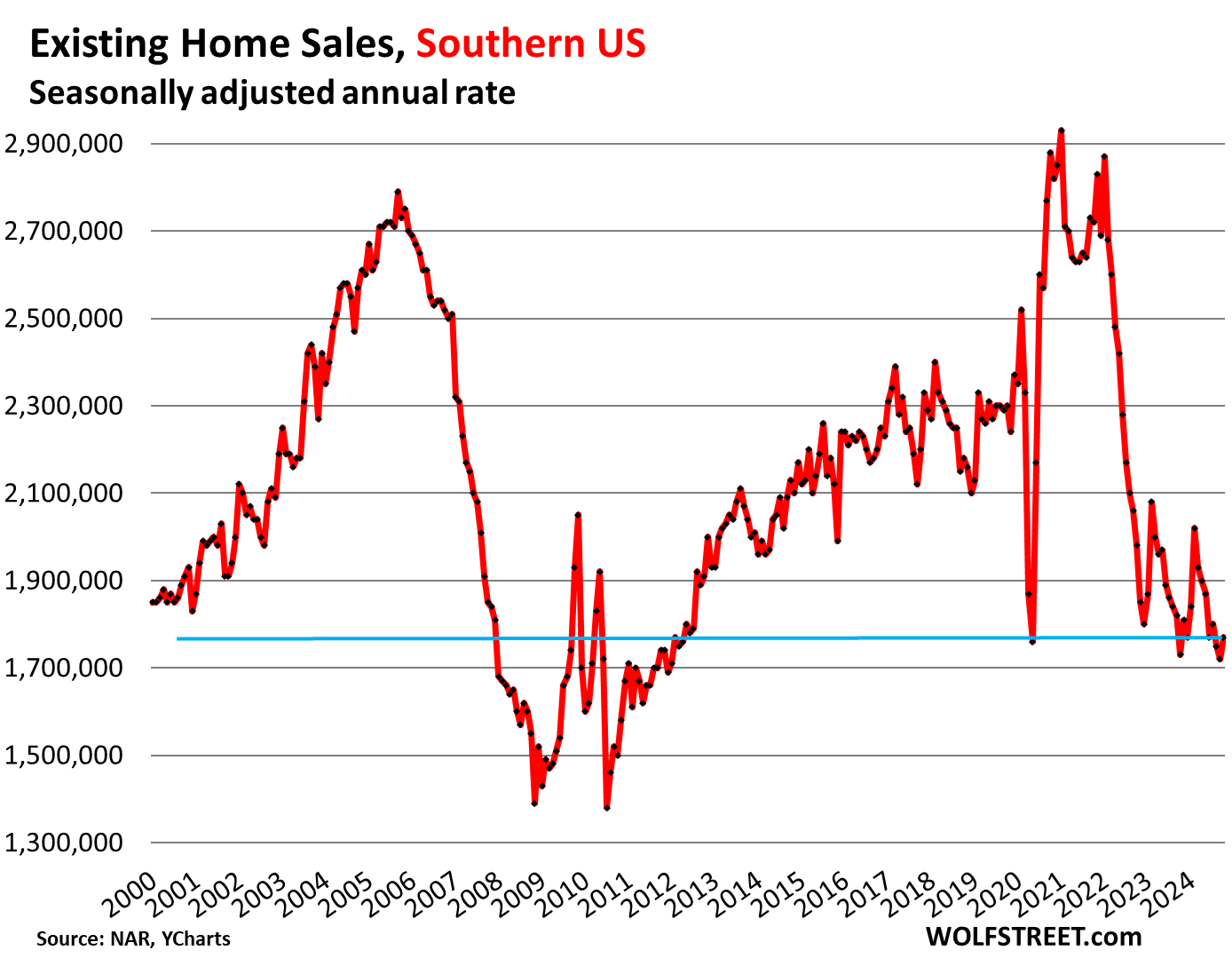
Western US: The seasonally adjusted annual rate of sales rose to 770,000:
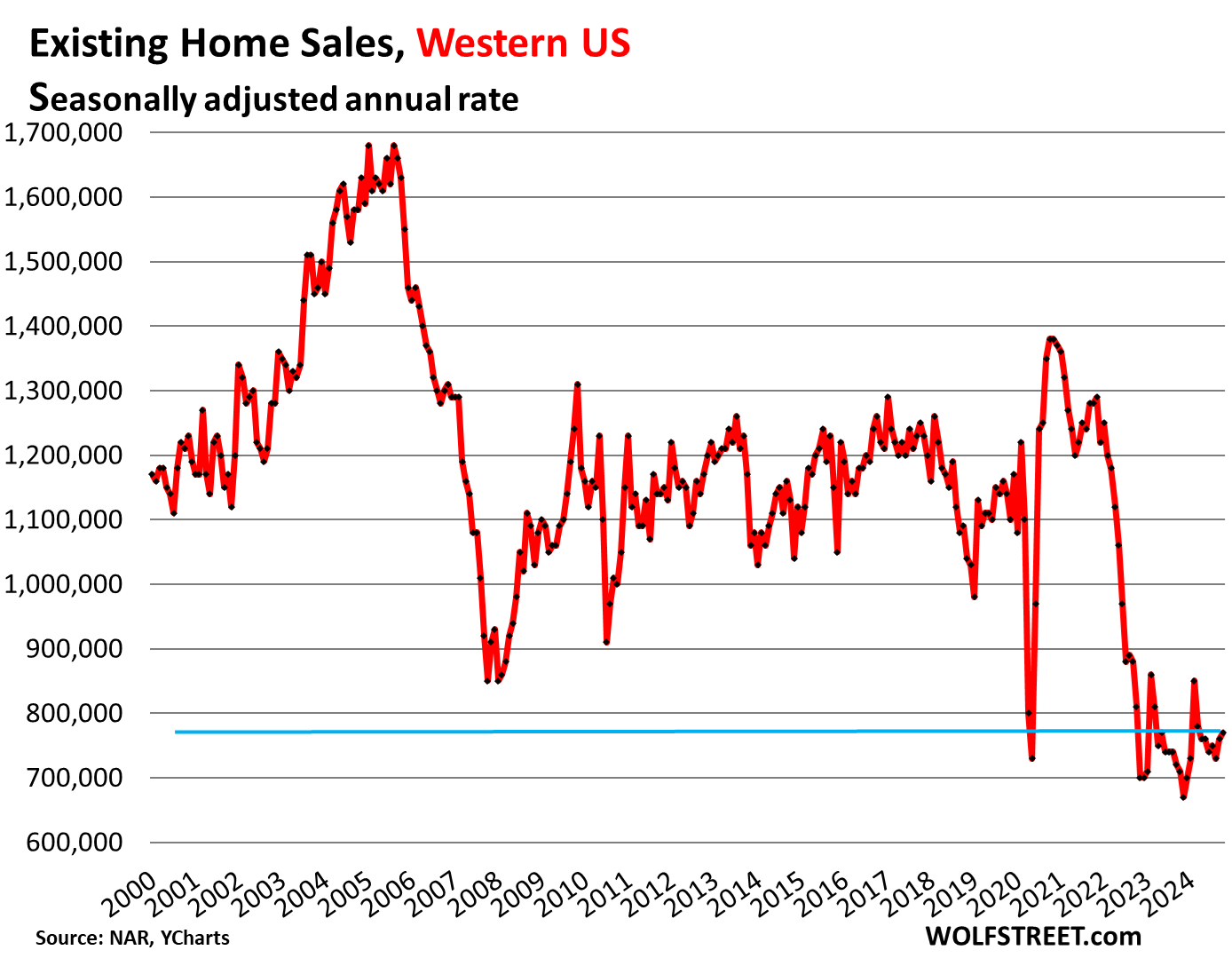
Enjoy reading WOLF STREET and want to support it? You can donate. I appreciate it immensely. Click on the beer and iced-tea mug to find out how:
Would you like to be notified via email when WOLF STREET publishes a new article? Sign up here.
![]()
The post Demand Destruction for Existing Homes: Sales in 2024 Track Lowest since 1995 amid Highest Supply for October in 6 Years appeared first on Energy News Beat.
Energy News Beat

